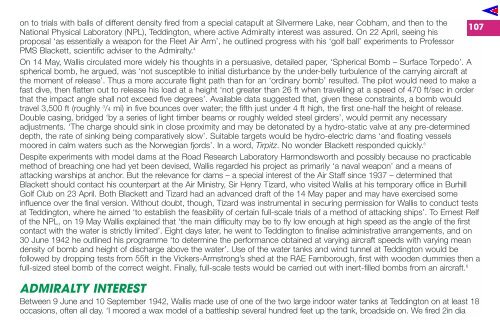Volume 5 No 2 - Royal Air Force Centre for Air Power Studies
Volume 5 No 2 - Royal Air Force Centre for Air Power Studies
Volume 5 No 2 - Royal Air Force Centre for Air Power Studies
Create successful ePaper yourself
Turn your PDF publications into a flip-book with our unique Google optimized e-Paper software.
on to trials with balls of different density fired from a special catapult at Silvermere Lake, near Cobham, and then to the<br />
107<br />
National Physical Laboratory (NPL), Teddington, where active Admiralty interest was assured. On 22 April, seeing his<br />
proposal ‘as essentially a weapon <strong>for</strong> the Fleet <strong>Air</strong> Arm’, he outlined progress with his ‘golf ball’ experiments to Professor<br />
PMS Blackett, scientific adviser to the Admiralty. 4<br />
On 14 May, Wallis circulated more widely his thoughts in a persuasive, detailed paper, ‘Spherical Bomb – Surface Torpedo’. A<br />
spherical bomb, he argued, was ‘not susceptible to initial disturbance by the under-belly turbulence of the carrying aircraft at<br />
the moment of release’. Thus a more accurate flight path than <strong>for</strong> an ‘ordinary bomb’ resulted. The pilot would need to make a<br />
fast dive, then flatten out to release his load at a height ‘not greater than 26 ft when travelling at a speed of 470 ft/sec in order<br />
that the impact angle shall not exceed five degrees’. Available data suggested that, given these constraints, a bomb would<br />
travel 3,500 ft (roughly 3 /4 mi) in five bounces over water; the fifth just under 4 ft high, the first one-half the height of release.<br />
Double casing, bridged ‘by a series of light timber beams or roughly welded steel girders’, would permit any necessary<br />
adjustments. ‘The charge should sink in close proximity and may be detonated by a hydro-static valve at any pre-determined<br />
depth, the rate of sinking being comparatively slow’. Suitable targets would be hydro-electric dams ‘and floating vessels<br />
moored in calm waters such as the <strong>No</strong>rwegian fjords’. In a word, Tirpitz. <strong>No</strong> wonder Blackett responded quickly. 5<br />
Despite experiments with model dams at the Road Research Laboratory Harmondsworth and possibly because no practicable<br />
method of breaching one had yet been devised, Wallis regarded his project as primarily ‘a naval weapon’ and a means of<br />
attacking warships at anchor. But the relevance <strong>for</strong> dams – a special interest of the <strong>Air</strong> Staff since 1937 – determined that<br />
Blackett should contact his counterpart at the <strong>Air</strong> Ministry, Sir Henry Tizard, who visited Wallis at his temporary office in Burhill<br />
Golf Club on 23 April. Both Blackett and Tizard had an advanced draft of the 14 May paper and may have exercised some<br />
influence over the final version. Without doubt, though, Tizard was instrumental in securing permission <strong>for</strong> Wallis to conduct tests<br />
at Teddington, where he aimed ‘to establish the feasibility of certain full-scale trials of a method of attacking ships’. To Ernest Relf<br />
of the NPL, on 19 May Wallis explained that ‘the main difficulty may be to fly low enough at high speed as the angle of the first<br />
contact with the water is strictly limited’. Eight days later, he went to Teddington to finalise administrative arrangements, and on<br />
30 June 1942 he outlined his programme ‘to determine the per<strong>for</strong>mance obtained at varying aircraft speeds with varying mean<br />
density of bomb and height of discharge above the water’. Use of the water tanks and wind tunnel at Teddington would be<br />
followed by dropping tests from 55ft in the Vickers-Armstrong’s shed at the RAE Farnborough, first with wooden dummies then a<br />
full-sized steel bomb of the correct weight. Finally, full-scale tests would be carried out with inert-filled bombs from an aircraft. 6<br />
ADMIRALTY INTEREST<br />
Between 9 June and 10 September 1942, Wallis made use of one of the two large indoor water tanks at Teddington on at least 18<br />
occasions, often all day. ‘I moored a wax model of a battleship several hundred feet up the tank, broadside on. We fired 2in dia
















